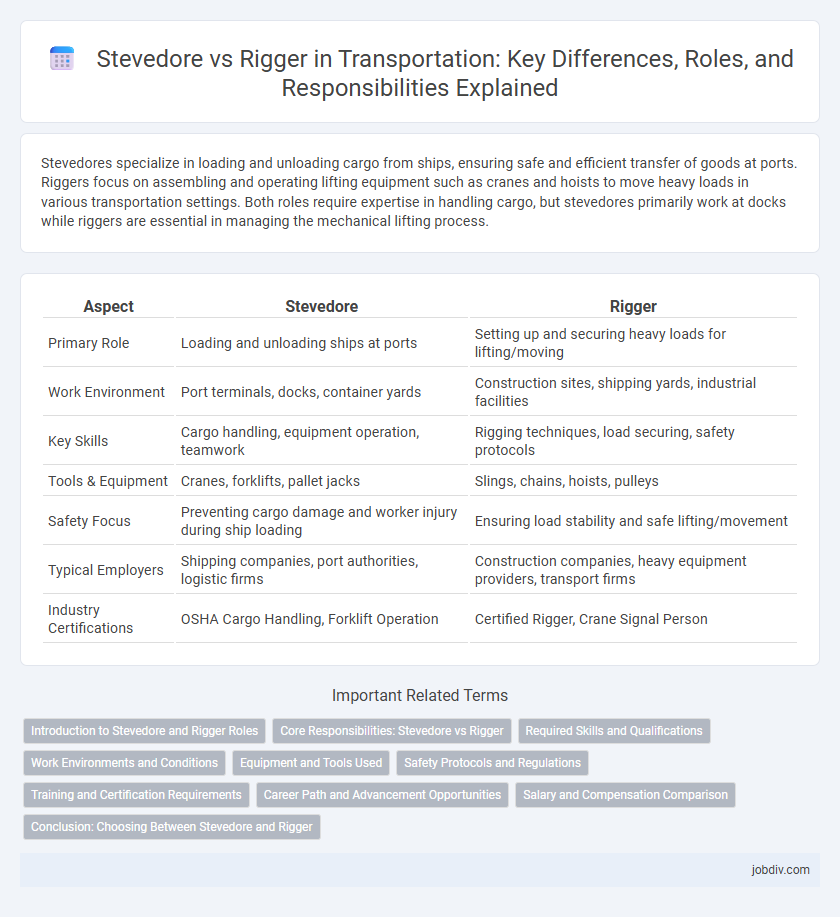Stevedores specialize in loading and unloading cargo from ships, ensuring safe and efficient transfer of goods at ports. Riggers focus on assembling and operating lifting equipment such as cranes and hoists to move heavy loads in various transportation settings. Both roles require expertise in handling cargo, but stevedores primarily work at docks while riggers are essential in managing the mechanical lifting process.
Table of Comparison
| Aspect | Stevedore | Rigger |
|---|---|---|
| Primary Role | Loading and unloading ships at ports | Setting up and securing heavy loads for lifting/moving |
| Work Environment | Port terminals, docks, container yards | Construction sites, shipping yards, industrial facilities |
| Key Skills | Cargo handling, equipment operation, teamwork | Rigging techniques, load securing, safety protocols |
| Tools & Equipment | Cranes, forklifts, pallet jacks | Slings, chains, hoists, pulleys |
| Safety Focus | Preventing cargo damage and worker injury during ship loading | Ensuring load stability and safe lifting/movement |
| Typical Employers | Shipping companies, port authorities, logistic firms | Construction companies, heavy equipment providers, transport firms |
| Industry Certifications | OSHA Cargo Handling, Forklift Operation | Certified Rigger, Crane Signal Person |
Introduction to Stevedore and Rigger Roles
Stevedores specialize in loading and unloading cargo from ships, ensuring efficient and secure handling of goods at ports using cranes and other dock equipment. Riggers focus on the assembly, adjustment, and disassembly of lifting gear and tackle, facilitating safe movement of heavy materials on construction sites and industrial settings. Both roles require expertise in safety protocols, equipment operation, and team coordination to optimize transportation logistics and cargo handling.
Core Responsibilities: Stevedore vs Rigger
Stevedores specialize in loading and unloading cargo from ships, ensuring efficient and secure handling during maritime freight operations. Riggers focus on setting up, operating, and maintaining lifting equipment like cranes and hoists to safely move heavy materials in ports and construction sites. Both roles emphasize safety and precision but differ in equipment expertise and operational context within transportation logistics.
Required Skills and Qualifications
Stevedores require skills in cargo handling, heavy lifting, and operating dock machinery, with qualifications often including certifications in safety protocols and equipment operation. Riggers specialize in securing and moving heavy loads using ropes, chains, and cranes, necessitating in-depth knowledge of load dynamics and rigging techniques, along with certifications such as NCCCO or equivalent. Both roles demand physical strength, attention to detail, and adherence to occupational safety standards to ensure efficient and risk-free transportation operations.
Work Environments and Conditions
Stevedores typically work on docks and ships, loading and unloading cargo in outdoor and often harsh maritime environments subjected to variable weather conditions and heavy machinery. Riggers operate in diverse settings, including construction sites, warehouses, and shipyards, focusing on assembling and securing loads under strict safety protocols, often at heights or confined spaces. Both roles require physical strength and adherence to safety standards, but stevedores face more exposure to maritime elements while riggers encounter varied structural challenges.
Equipment and Tools Used
Stevedores primarily use heavy machinery such as cranes, forklifts, and container handlers to load and unload cargo from ships efficiently. Riggers specialize in equipment like hoists, slings, shackles, and pulleys to secure and maneuver loads safely during lifting operations. Both professionals rely on specialized tools tailored to their roles, with stevedores handling large-scale cargo movement and riggers ensuring precise load positioning and safety.
Safety Protocols and Regulations
Stevedores and riggers both operate under stringent safety protocols to mitigate risks related to heavy cargo handling and lifting operations in transportation hubs. Stevedores follow maritime-specific regulations such as the International Maritime Organization's Safety of Life at Sea (SOLAS) and implement personal protective equipment (PPE) standards to prevent accidents during loading and unloading of ships. Riggers adhere to Occupational Safety and Health Administration (OSHA) guidelines, focusing on secure rigging practices and equipment inspections to ensure the stability and safety of suspended loads during transport and construction activities.
Training and Certification Requirements
Stevedores require specialized training in cargo handling, ship loading, and adherence to maritime safety regulations, often obtaining certification through programs such as the International Maritime Organization (IMO) standards. Riggers must complete rigorous training in load securing, crane signaling, and safety protocols, with certification typically provided by bodies like the National Commission for the Certification of Crane Operators (NCCCO). Both roles demand practical experience and ongoing education to comply with Occupational Safety and Health Administration (OSHA) regulations and industry best practices.
Career Path and Advancement Opportunities
Stevedores specialize in loading and unloading ships, with career advancement often leading to supervisory roles like dock foreman or terminal manager, emphasizing operational expertise in maritime logistics. Riggers focus on assembling and dismantling heavy equipment, advancing toward positions such as rigging supervisor or safety coordinator, leveraging skills in construction and industrial settings. Both careers offer growth through certifications and experience, but stevedores typically progress within port operations while riggers expand into broader industrial maintenance and project management roles.
Salary and Compensation Comparison
Stevedores typically earn an average annual salary ranging from $35,000 to $55,000, depending on experience and location, while riggers often command higher wages between $45,000 and $70,000 due to specialized skills in heavy lifting and equipment handling. Compensation packages for riggers may include hazard pay and overtime premiums, reflecting the physically demanding and high-risk nature of their tasks. Stevedores, employed mainly in port operations, often receive union benefits and pension plans that contribute to their total compensation.
Conclusion: Choosing Between Stevedore and Rigger
Choosing between a stevedore and a rigger depends on the specific transportation and cargo handling needs; stevedores specialize in loading and unloading ships while riggers focus on assembling and moving heavy equipment. For maritime freight operations requiring efficient ship cargo management, stevedores provide expert skills and safety protocols. In contrast, projects involving complex lifting and rigging tasks benefit from riggers' technical expertise in securing and maneuvering heavy loads.
Stevedore vs Rigger Infographic

 jobdiv.com
jobdiv.com